This article is written by Lyngeolle Morris who is pursuing a Certificate Course in Intellectual Property Law and Prosecution from LawSikho.
Table of Contents
Introduction
Germany has been considered as a steady global leader in the areas of science, technology, research, and development over several decades, and has been globally acclaimed for its quality of innovations.
According to the Global Competitiveness Report (2019), Germany was named as having the ‘best innovation capability in the world based on the World Economic Forum’s Global Competitiveness Index 4.0.
Germany has placed significant efforts in developing and maintaining a strong intellectual property framework which has been supported by a comprehensive legal and regulatory regime with the view of ensuring that proprietors of intellectual property are able to preserve, protect and monetize their innovative works. Moreover, through its strong institutional frameworks such as the country’s ease of access to information on intellectual property rights and its highly educated population in the areas of science and technology, this has paved the way for the country to be seen as a world-class leader in the area of intellectual property (Global Innovation Index, 2020).
In this article, we will focus on four aspects of Germany’s intellectual property regulatory regime, namely copyright, patents, utility models, trademarks. We will also consider what lessons can be learned through Germany’s example as a leader in the field of intellectual property.
Intellectual property rights in Germany
Copyright
Copyright provides for the protection of an individual’s original innovative works which have been made in the express form. In Germany, there is no requirement for the creative work to be registered and therefore, copyright protection once the work has been created.
Copyright protection in Germany is governed by the following statutes:
- The Act on Copyright and Related Rights (Urheberrechtsgesetz, UrhG) of 9 September 1965, as last amended by Article 1 of the Act of 28 November 2018 (‘the Copyright Act). The translated version as provided in English by the Federal Ministry of Justice and Consumer Protection and the Federal Office of Justice may be found here: https://www.gesetze-im-internet.de/englisch_urhg/englisch_urhg.pdf
- The Act on the Management of Copyright and Related Rights by Collecting Societies. the full English translation can be found at: https://www.gesetze-im-internet.de/englisch_vgg/englisch_vgg.html as provided by The Federal Ministry of Justice and Consumer Protection
Protected works
Under Section 2 of the Copyright Act, works under copyright protection include:
- Literary works
- Musical works
- Pantomimic works
- Artistic works
- Photographic works
- Cinematographic works
- Illustrations (scientific or technical)
Pursuant to section 2(2) and section 7 of the Copyright Act, the works in question must be those of the author in order to receive copyright protection.
Rights conferred on the copyright holder
Sections 11-15 of the Copyright Act provide the instances in which the author may utilize its exclusive right to exploit his or her works. These include the following rights:
- Right to determine the manner of publication of one’s work
- Eight to be identified as the author of one’s work
- Right to prevent another from distorting or making a derogatory treatment of one’s work
- Right of reproduction
- Right of distribution
- Right of exhibition
- Right of recitation, performance, and presentation
- Right of making the work available to the public
- Right of broadcasting
- Communication by video or audio
- Communication of broadcasts and work made available to the public
Duration of copyright protection
A copyright holder is granted protection for the creative work for the duration of the author’s lifetime and will continue seventy (70) years after the death of the author. (Section 64, Copyright Act). In the instance of joint authors, the copyright will expire 70 years after the last surviving joint author dies. (Section 65, Copyright Act)
In the case of anonymous and pseudonymous works, the copyright protection will last 70 years from the date of publication of the work. (Section 66, Copyright Act)
Transfer and succession of works
In Germany, copyright can be transferred on inheritance (Section 28, Copyright Act). This may be done by way of a testamentary disposition or to co-heirs where there is the partition of an estate. (Section 29, Copyright Act).
Copyright may be transferred for the purpose of exploitation of rights of use whether by way of a non-exclusive or exclusive contractual arrangement. (Section 39, copyright Act).
In the case of audio recordings, where the author of a musical work grants a right of use to a producer, the author will also be compulsorily required to grant a right of use to any other producer of audio recordings whose main establishment or residence is within Germany. (Section 42a, Copyright Act)
Infringement
Under German copyright law, an author whose rights have been infringed is first required to give notification to the infringing party by calling upon him/her to desist from the infringing conduct and further must allow for an opportunity to have the matter settled before instituting legal proceedings. (Section 97a (1), Copyright Act).
The Copyright Act also provides specific details on what should be included in the notice namely:
- The name of the injured party
- Description of the infringement
- Claims for damage and compensation
- The extent of proposals to desist from the infringing conduct (if a request to enter into an agreement to desist has been made) (see: Section 97a(2), Copyright Act).
Enforcement
Infringement of copyright law is considered both a civil and a criminal offense. As such proceedings may be initiated pursuant to the Code of Civil Procedure (Zivilprozessordnung) (for civil claims) and pursuant to the Code of Criminal Procedure (Strafprozeßordnung). (see Sections 97– 105 Copyright Act for civil claims; see Section 106-111a).
Remedies
Some of the remedies available to parties whose copyrights have been infringed include:
-
- Claim to have copies of the works destroyed
- Claim to recall unlawfully produced or distributed material
- Claim to have the injured party’s property released
- Claim for injunctive relief
- Claim for damages
- Confiscation
- Sanction with regulatory fine (see Sections 97-111a)
Patents
Patent protection involves the granting of exclusive rights to an investor, provided that the said inventor can meet the requirements that the invention is new, has an inventive step, and is susceptible to the industrial application (see Section 1, Patent Act). In Germany, the procedure entailed in the acquisition of patent rights is governed primarily by the Patent Act (Patentgesetz, PatG). A copy of the Patent Act may be found here: https://www.gesetze-im-internet.de/englisch_patg/englisch_patg.html
The legal framework is also governed by the Ordinance on Patent Procedures before the German Patent and Trade Mark Office (Patent Ordinance – Verordnung zum Verfahren in Patentsachen vor dem Deutschen Patent- und Markenamt) which sets out the filing processes and formal requirements for preparing and submitting a patent application. A copy of the Patent Ordinance may be found here: https://wipolex-res.wipo.int/edocs/lexdocs/laws/en/de/de147en.pdf
Patent protection in Germany lasts for twenty (20) years from the date following the filing of the patent application. Patents are filed with the German Patent and Trademark Office (Das Deutsche Patent- und Markenamt or ‘DMPA’). The guidelines, laws, and procedures governing the patent process may be found on its webpage at: https://www.dpma.de/english/our_office/law/index.html.
In the alternative, a patent may be filed as a European application under the European Patent Convention or as an international application pursuant to the Patent Cooperation Treaty (Section 3, Patent Act).
What is patentable?
- Inventions in the field of technology
- Inventions that consist of biological material (as defined by the Patent Act)
- Inventions that consist of a microbiological or technical process (as defined by the Patent Act) (see Section 1, 2a(2), Patent Act)
What cannot be patented?
Under the German patent system, a patent would not be issued by the DMPA:
-
- Discoveries, scientific theories, mathematical methods
- Aesthetic creations
- Schemes, rules and methods, games, business processes, computer program
- Presentations
- The human body and its formation, development, and its elements
- Processes for cloning human
- Processes for modifying the genetic identity of a human
- Uses of human embryos
- Modification of an animal’s genetic identity
- Plant and animal varieties
- Treatment methods for humans or animals for surgery, therapy, and diagnostic methods (exception: substances or compositions used in relation to these methods)
(see Section 1(3), Section 1 a, Section 2, Section 2a of Patent Act)
Filing requirements
Under Section 34 (3) of the Patent Act, the patent application must be filed in the German language failing which the patent office requires that the applicant file the application with a German translation within three (3)months from the filing date and twelve (12) months in the case of applications in English or French. If this is not undertaken within the time limit, the application would be considered withdrawn (Section 35 a, Patent Act). Pursuant to Section 34(3) of the Patent Act, each patent application must contain the following:
- The applicant’s name
- A request for the grant of the patent
- The patent claim or claims
- A description of the patent
- Relevant drawings
An applicant has the right to make amendments to the application prior to a decision being made regarding the grant of the patent and must not be changed to the subject matter of the application. (Section 38, Patent Act)
According to the DMPA’s Guidelines for the Examination Procedure (January 2019) (‘Examination Guidelines’), once the German Patent Office has approved patentability, the application would be deemed as valid. However, if the application is deemed valid but contains deficiencies, the examiner would invite the applicant to comment on the specified deficiencies. The applicant will then be required to respond to the examining section, failing which the application may be refused (Examination Guidelines).
The applicant is also required to file an abstract and this must be done within fifteen (15) months from the filing date of the application or from another earlier date that may be claimed to govern the patent application. The abstract must include the following information:
- The title of the invention
- A summary of the disclosure found in the patent application (outlining the technical problem, the solution, and the use)
- A drawing of the invention (if any)(see Section 36, Patent Act)
Once the application has been approved, the applicant will be required to pay the relevant application fee pursuant to the Patent Costs Act. The application would be deemed as withdrawn if the applicant fails to make the necessary payment (Section 3, 6 Patent Costs Act). A detailed brochure on the patent fees may be found on the DMPA’s Brochure: ‘Information Concerning Costs, Fees and Expenses of the German Patent and Trademark Office and of the Federal Patent Court’. A copy of the brochure may be accessed here: https://www.dpma.de/docs/english/formulare/allg_eng/a9510_1.pdf
An overview of some of the patent filing fees is illustrated below:
Once the patent application has been accepted and all deficiencies have been remedied by the application, there will be a declaration given to that effect which would be recorded in the Register as well as published in the Patent Gazette (Datenblatt) (Section 23, Patent Act). Once the grant has been published in the Patent Gazette, the patent would be deemed as having a legal effect upon publication. (Section 58, Patent Act)
Duration
Patent protection in Germany lasts for twenty (20) years from the date following the filing of the patent application (Section 16, Patent Act).
Effect of the patent
The grant of the patent has the effect of granting the patent holder the right to the patent and that right also devolves on the patent holder’s heirs. The patent holder also has the right to transfer the right either through exclusive or non-exclusive licenses. (Section 15, Patent Act).
Utility models
In Germany, an application for utility model protection may also be made pursuant to Germany’s Utility Model Act (Gebrauchsmuster), a copy of which can be accessed here: http://www.gesetze-im-internet.de/gebrmg/
The application follows similar procedures to those found in the patent filing. However, it is a separate and distinct application from a patent application and is deemed as a low-cost method for protecting inventions.
Duration, effect, and fees
The duration of the protection once approved by the Patent and Trademark Office is ten (10) years from the date of filing the application (Section 23, Utility Model Act).
When a utility model grant is registered, it can be used as establishing priority status for a future patent application (Section, 5, 6 Utility Model Act). The effect of the registration of a utility model is to grant the holder an exclusive right against third parties, and the extent of protection will be determined by what is found in the claims (Section 12a, Utility Model Act)
The fees for a utility model can be found in the DMA’s brochure on utility models. A screenshot of the relevant costs is illustrated on page four of Utility Models:
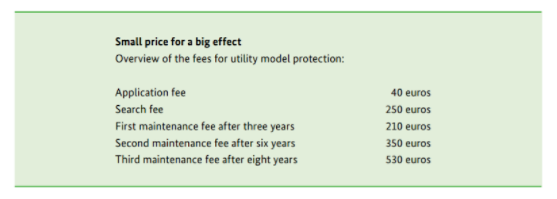
An information brochure on utility model protection by the German Patent and Trademark Office (Nov 2017), https://www.dpma.de/docs/english/broschueren_eng/bro_utilitymodels_en.pdf.
Trademarks
Trademark law in Germany is primarily governed by the Act on the Protection of Trademarks and Other Signs or Markengesetz (‘Trademark Act’) and the Ordinance Implementing the Trade Mark Act (Trade Mark Ordinance). Translated copies of these laws in English can be found here:
- http://www.gesetze-im-internet.de/englisch_markeng/englisch_markeng.pdf
- https://www.dpma.de/docs/english/formulare/marken_eng/w7730_1.pdf
It should be noted that there have been a number of changes in recent years to the Trademark Act so as to align certain elements with the European Union Intellectual Property Office (EUIPO) (German Patent and Trademark Office, October 2020).
As such, applications for trademarks are filed before the German Patent and Trademark Office or alternatively as a European Union Trademark.
According to the DPMA, there are a number of reasons why it is beneficial to file a trademark in Germany versus a European Union (‘EU’) Trademark. Some of the reasons provided are as follows:
- Speed and simplicity through an online process
- Low costs compared to the EU process
- National protection
- Less likely to be challenged in a broad EU market
- More appropriate for company or business conducting business in Germany and who wishes to later expand protection
- Registration effective after the examination process whereas under the EU, registration become effective after the examination process and opposition proceedings
- A registered national trademark allows for the seniority of an earlier identical mark when applying for an EU mark
(See: ‘Trademark Protection Abroad’ by German Patent and Trademark Office, October 2020 accessed here: https://www.dpma.de/docs/marken/1/good_reasons.pdf)
What can be trademarked?
Trademarks under Germany’s legal regime are defined as signs including words, names, designs, letters, numerals, sounds, marks, 3-D designs, shapes of goods or their packing, wrapping, colors, color combinations, provided they can distinguish the goods or services being offered (Section 3 (1), Trademark Act)
What cannot be protected as trademarks?
The following signs would not receive trademark protection. These include signs that:
- Correspond with the nature of the goods being sold
- Provides a technical result or;
- Provides substantial value to the goods.
(see Section 3 (2), Trademark Act)
How is a trademark protected?
A trademark may be protected under the Trademarks Act through registration, usage of the sign resulting in public recognition of the trademark, or by virtue of Section 6b is of the Paris Convention for the Protection of Industrial Property (Paris Convention) if the mark is well known in Germany (Section 4, Trademark Act)
In Germany, a natural person, legal person, or partnership has the right to file and have ownership of a trademark (Section 7, Trademark Act)
Grounds of refusal of a mark
- Absolute grounds
Under German law, there is a comprehensive list of absolute grounds under which a mark may be refused for registration purposes. These include:
- Signs which cannot be depicted clearly and precisely
- Signs which do not meet the requirement of distinctiveness
- Signs which solely indicate the type or quality of the service
- Signs which correspond with the industry of the goods or services
- Signs which have the effect of deceiving the public
- Signs which are contrary to public policy, morality, prohibited in the public interest or in the interest of bad faith
- Signs which contain national or international emblems and symbols
- Signs which contain symbols of control or warranty
(see Section 8, Trademark Act).
- Relative Grounds
Under Section 9 of the Trademark Act, registration may be refused on the following relative grounds:
- A sign that is identical in nature to another which have been previously registered or filed and the goods or services in question are also similar
- There would be some confusion to the public if registered due to similarities with another previously registered or filed mark and similarities with the goods or services
- The registration is likely to be detrimental to the trademark of another well-known mark in Germany notwithstanding that the goods or services or not similar
Effect of registration
The effect of registration of a trademark is that it grants the owner an exclusive right to the mark and prohibits third parties from using a mark that is identical or likely to cause confusion to the public or be detrimental to the owner of the trademark (Section 14, 15, Trademark Act). The only exception is where the proprietor of the trademark grants his/her consent for usage (Section 11, 26, Trademark Act).
According to Section 47 of the Trademark Act, the protection granted by a registered trademark commences from the filing date and ends after ten years on the last day of the month which corresponds to the month when the application was filed. Trademark protection may be further extended by ten years (Section 47 (2), Trademark Act).
Fees
Once the appropriate requirements have been met and the fees are paid, the certificate of registration would be issued. The relevant fees payable to the DMPA including application fees, class fees, examination fees, and renewal fees are illustrated below:
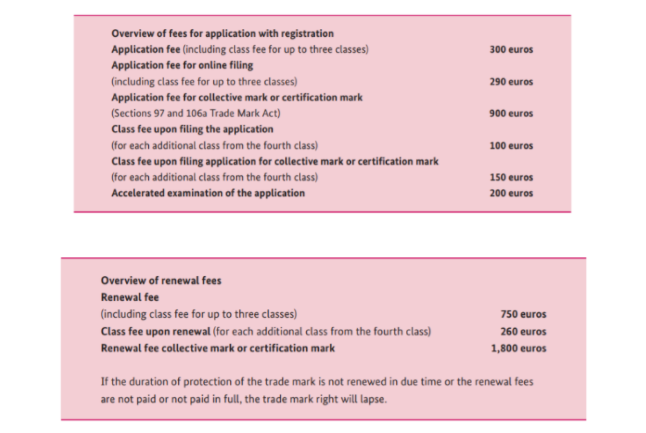
Refer ‘Trade Marks: An information brochure on trademark protection’ by the German Patent and Trademark Office, https://www.dpma.de/docs/dpma/veroeffentlichungen/broschueren/210318_bromarken_engl.pdf.
Remedies in event of an infringement
The trademark owner has the following rights against an infringing party:
- Claim for compensation (Section 14, 19b)
- Right to an injunction (Section 14)
- Right to destruction and recall (Section 18)
- Right to information (Section 19)
- Claim for production and inspection (Section 19a)
- Publication of judgments (Section 19c)
The DMPA also provides helpful tips on trademark registration and usage which can be found on their webpage.
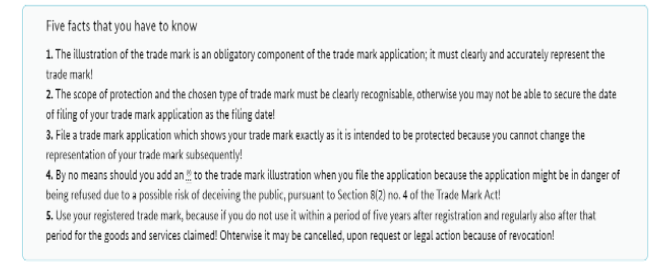
(Refer: ‘Trademarks’ by German Patent and Trademark, https://www.dpma.de/english/trade_marks/application/required_data_for_filing_an_application/index.html)
A useful illustration of the full trademark registration process in Germany as summarized by the DMPA is provided below. It outlines the following processes entailed in the trademark application. These include the application; receipt of application or publication of application; notification of deficiencies (if any); remedies made; registration or refusal; appeal process; publication; opposition; service; examination of opposition; and appeal process.

(Refer ‘Trademarks’ by German Patent and Trademark Office, https://www.dpma.de/english/trade_marks/application/required_data_for_filing_an_application/index.html).
Conclusion
Germany has a comprehensive legal framework with clear systems on registration, protection, enforcement, and remedies in the areas of copyright, patents, utility models, and trademark procedures. In keeping with its statutory duty to inform the public about Germany’s intellectual property rights, the German Patent and Trademark Office provides detailed information on the various processes involved in intellectual property protection for patents, trademarks, utility models, and designs as well as specialized training for attorneys. By having robust institutional structures and systems in place, this, in turn, has impacted upon the strength of the country’s regulatory environment, and no doubt has contributed to Germany’s impressive intellectual property regime.
Lessons that can be learned from Germany
According to the Global Innovation Index Report (2020), Germany ranks number 9 in the world out of 131 economies assessed. The Global Innovation Index makes an assessment of a country’s innovation capabilities by measuring seven (7) pillars including the country’s: institutions, human capital and research, infrastructure, market sophistication, business sophistication, knowledge and technology inputs, and creative inputs. The framework of the Global Innovation Index is illustrated below:
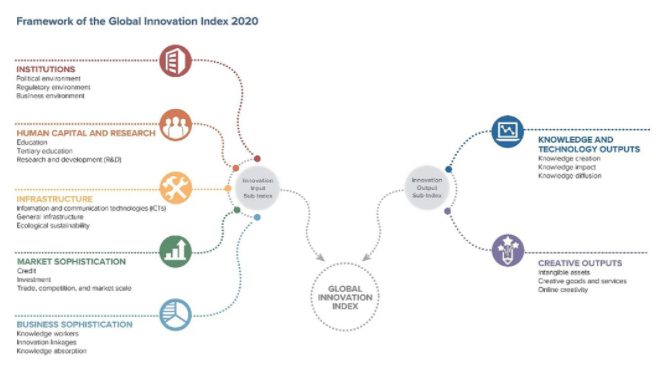
(Refer: Framework of the Global Innovation Index 2020’ from the Global Innovation Index 2020: Who Will Finance Innovation? By Cornell University, INSEAD, WIPO | Publication year: 2020).
In 2019, the DPMA reported here that applications with the DPMA and Patent Cooperation Treaty amounted to 67, 432 applications. According to the DPMA in 2019 the majority of the applications were received from the automotive industry. As of 2020, a total of 834,584 patents were valid in Germany as stated by the DPMA in a statistical report found here.
Germany also boasts some of the world’s most prestigious brands, indicating that the country has a strong focus on the high quality of its innovations. Some of its well-known brands in the automobile industry include Volkswagen, Mercedes-Benz, Audi, BMW, and Porsche. According to Germany’s Global Innovation Index Report (2020), Germany ranks number 10 in the quality of higher education institutions such as Technische Universität München. This, together with its strong legal framework, ease of filing and registration for intellectual property, its cultural attitude towards encouraging a high-quality innovative market, and its mandate to ensure the protection of innovative works are all aspects which many other jurisdictions can emulate.
References
- Patent Act as published on 16 December 1980 (Federal Law Gazette 1981 I p. 1), as last amended by Article 4 of the Act of 8 October 2017 (Federal Law Gazette I p. 3546), https://www.gesetze-im-internet.de/englisch_patg/englisch_patg.html. Accessed 30 March 2021.
- The Act on Copyright and Related Rights (Urheberrechtsgesetz – UrhG) Copyright Act of 9 September 1965 (Federal Law Gazette I, p. 1273), as last amended by Article 1 of the Act of 28 November 2018 (Federal Law Gazette I, p. 2014), https://www.gesetze-im-internet.de/englisch_urhg/englisch_urhg.pdf. Accessed 10 April 2021.
- The Act on the Management of Copyright and Related Rights by Collecting Societies of 24 May 2016 (Federal Law Gazette I p. 1190), as last amended by Article 14 of the Act of 17 July 2017 (Federal Law Gazette I p. 2541), https://www.gesetze-im-internet.de/englisch_vgg/englisch_vgg.html. Accessed 10 April 2021.
- The Act on the Protection of Trade Marks and Other Signs or Markengesetz (‘Trademark Act’), http://www.gesetze-im-internet.de/englisch_markeng/englisch_markeng.pdf. Accessed 12 April 2021.
- The Ordinance Implementing the Trade Mark Act (Trade Mark Ordinance), 1 of 11 May 2004 (Federal Law Gazette22 I p. 872) last amended by Article 4 of the ordinance of 12 December 2018 (Federal Law Gazette I p. 2446, 2449), https://www.dpma.de/docs/english/formulare/marken_eng/w7730_1.pdf. Accessed 12 April 2021.
- The Ordinance on Patent Procedures before the German Patent and Trade Mark Office (Patent Ordinance) of 1 September 2003 (Federal Law Gazette1 I p. 1702), last amended by Article 1 of the Ordinance of 26 May 2011 (Federal Law Gazette I p. 996), https://wipolex-res.wipo.int/edocs/lexdocs/laws/en/de/de147en.pdf. Accessed 30 March 2021.
- The Utility Model Act as amended by the notice of 28 August 1986 (BGBl. I p. 1455), which was last amended by Article 10 of the Law of 17 July 2017 (BGBl. I p. 2541), http://www.gesetze-im-internet.de/gebrmg/. Accessed 29 March 2021.
- Cornell University, INSEAD, and World Intellectual Property Organization. “The Global Innovation Index 2020: Who Will Finance Innovation?” Dutta, Soumitra. Lanvin, Bruno. Wunsch-Vincent, Sacha (editors). Cornell University, INSEAD, and WIPO. 2020. Ithaca, Fontainebleau, and Geneva, https://www.wipo.int/edocs/pubdocs/en/wipo_pub_gii_2020.pdf. Accessed 13 March 2021.
- The German Patent and Trademark Office. “Services: Patent Fees”. 22 December 2020, https://www.dpma.de/english/services/fees/patents/index.html. Accessed 13 March 2021
- The German Patent and Trademark Office. “Trademarks: Required Data for Filing an Application. 20 October 2020, https://www.dpma.de/english/trade_marks/application/required_data_for_filing_an_application/index.html. Accessed 15 March 2021.
- The German Patent and Trade Mark Office and of the Federal Patent Court. “Information Concerning Costs, Fees and Expenses of the German Patent and Trade Mark Office and of the Federal Patent Court”. July 2020, https://www.dpma.de/docs/english/formulare/allg_eng/a9510_1.pdf. Accessed 31 March 2021.
- The German Patent and Trade Mark Office. “Guidelines for the Examination Procedure (Examination Guidelines)”. 11 January 2019, https://www.dpma.de/docs/english/formulare/patent_eng/p2796_1.pdf. Accessed 30 March 2021.
- The German Patent and Trademark Office Source. “Utility Models: An information brochure on utility model protection”. November 2017, https://www.dpma.de/docs/english/broschueren_eng/bro_utilitymodels_en.pdf. Accessed 18 March 2021.
- World Economic Forum. “The Global Competitiveness Report, 2019”. Schwab, Klaus (editor). World Economic Forum. 2019. Geneva, Switzerland, http://www3.weforum.org/docs/WEF_TheGlobalCompetitivenessReport2019.pdf. Accessed 13 March 2021.
Students of Lawsikho courses regularly produce writing assignments and work on practical exercises as a part of their coursework and develop themselves in real-life practical skills.
LawSikho has created a telegram group for exchanging legal knowledge, referrals, and various opportunities. You can click on this link and join:
 Serato DJ Crack 2025Serato DJ PRO Crack
Serato DJ Crack 2025Serato DJ PRO Crack


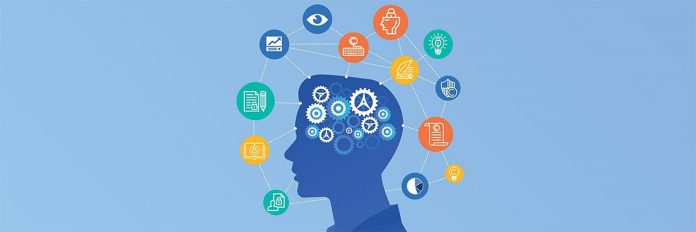







 Allow notifications
Allow notifications



